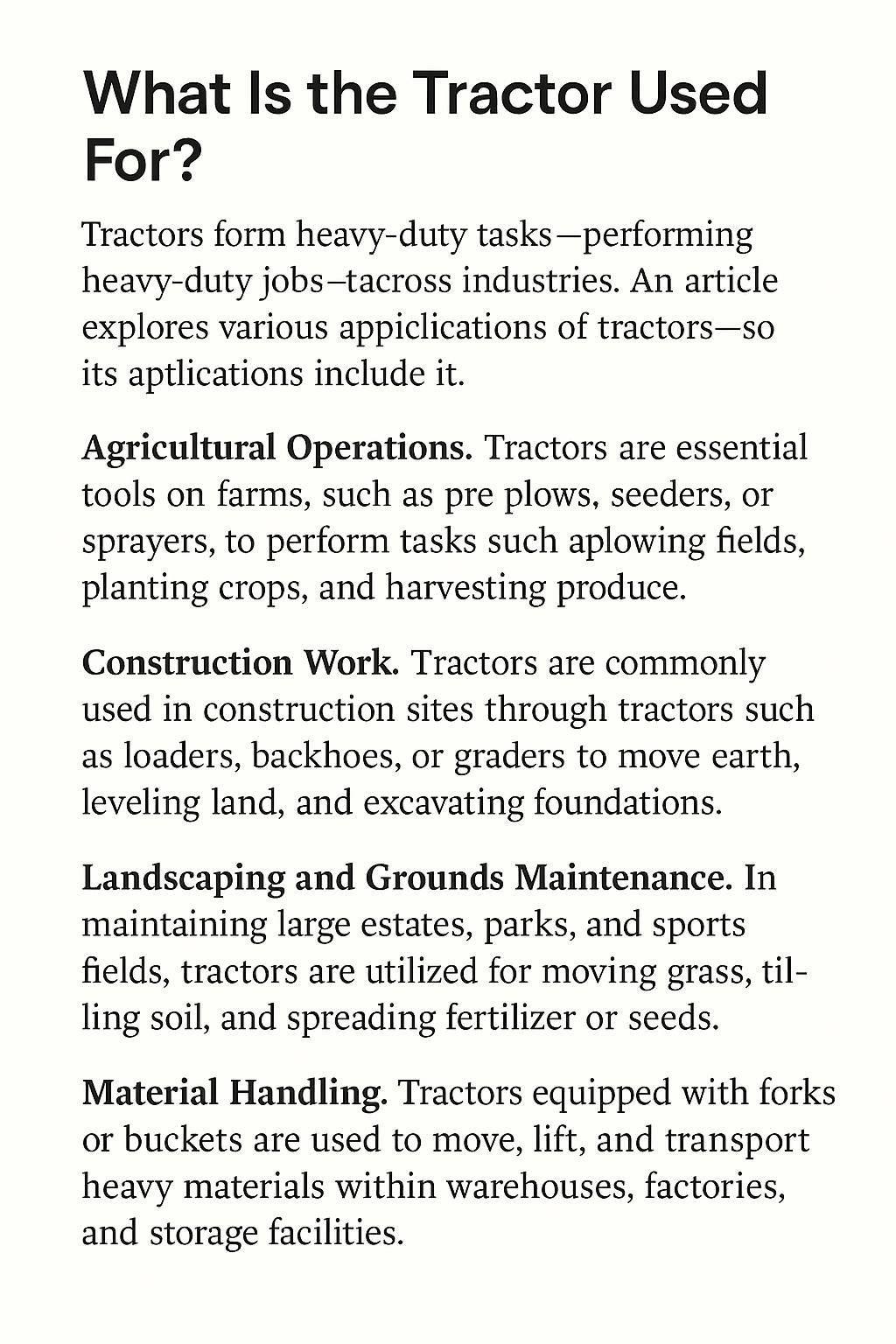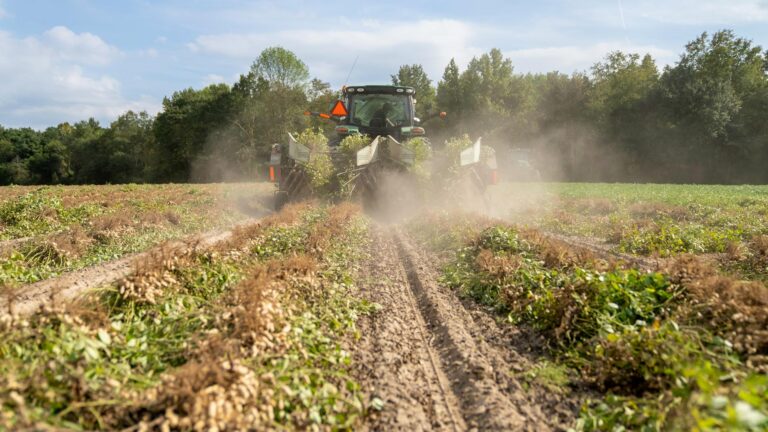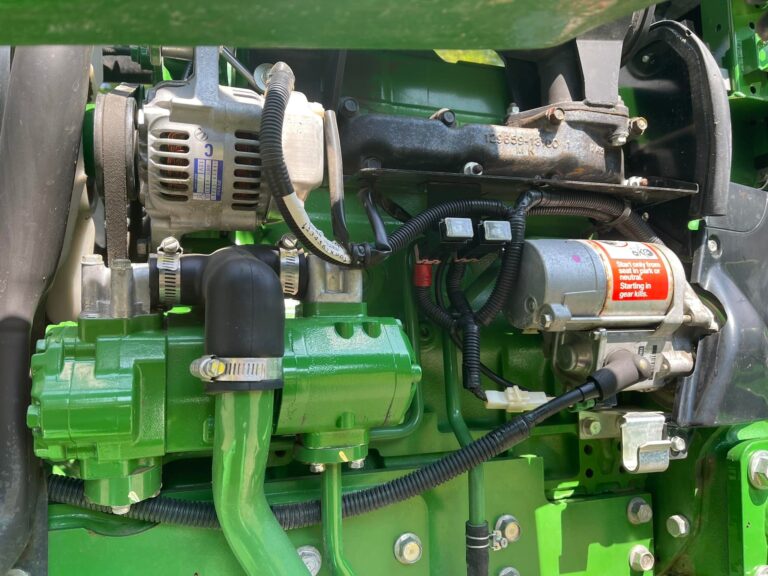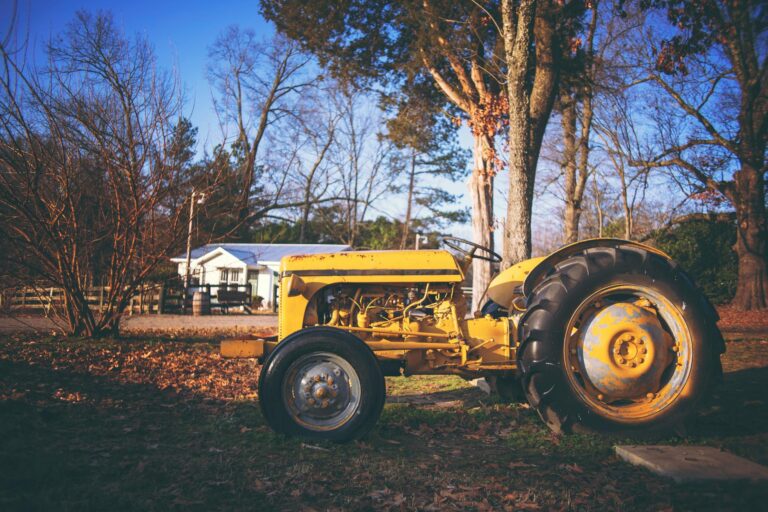When you hear the word “tractor”, you likely picture vast fields, powerful engines, and tireless machines churning soil under the open sky. But what is the tractor used for beyond plowing fields? The modern tractor has evolved into a multipurpose powerhouse that serves critical roles in agriculture, construction, landscaping, and various industrial applications.
In this detailed article, we’ll explore the various uses of tractors, their types, attachments, and the industries that rely on them. Whether you’re a farmer, landscaper, contractor, or just curious, this guide will provide everything you need to know about the utility of tractors in modern work.
What Is the Tractor Used For?
A tractor is a high-powered vehicle designed to deliver traction, power, and torque to mechanized tasks. It’s primarily used for pulling or pushing agricultural machinery, but its usage extends far beyond farming. Tractors are used in tilling, plowing, harrowing, planting, mowing, transporting goods, and even construction and road maintenance.
Today’s tractors can be fitted with a wide range of attachments, making them versatile and adaptable to countless tasks.
Primary Uses of Tractors
1. Agriculture: The Most Common Use of Tractors
Agriculture is where tractors shine the most. Farmers depend heavily on tractors to reduce manual labor and increase productivity. Here’s how tractors are used on farms:
a. Plowing and Tilling
Tractors pull plows and tillers to break and loosen the soil before planting. This process improves aeration and water absorption, laying the groundwork for a productive crop.
b. Planting and Seeding
With the help of seed drills and planters, tractors allow for precise planting of seeds in rows, optimizing space and maximizing yields.
c. Spraying and Fertilizing
Mounted sprayers or spreaders can be attached to tractors to distribute pesticides, herbicides, or fertilizers efficiently across large areas.
d. Harvesting
Combining harvesters or balers with tractors helps in gathering crops like grains, corn, and hay, significantly speeding up the process.
e. Transporting Goods
Tractors equipped with trailers can carry harvested crops, livestock feed, or equipment around the farm or to market.
2. Construction: Heavy-Duty Tasks
In the construction industry, tractors—particularly crawler tractors or bulldozers—play an essential role in preparing land and moving materials.
a. Land Grading and Leveling
Using blades or scrapers, tractors help in shaping and leveling land for roads, buildings, or drainage systems.
b. Material Handling
With front-end loaders or backhoes, tractors move soil, debris, gravel, and building materials on construction sites.
c. Demolition
Bulldozers, a type of tractor, can be used to demolish small structures or clear rubble.
3. Landscaping and Lawn Maintenance
In landscaping, tractors are used to mow lawns, move earth, dig holes, and even clear snow in winter.
a. Lawn Tractors
These smaller tractors are perfect for residential and commercial lawn care, equipped with mowing decks and bagging systems.
b. Compact Utility Tractors
Great for large gardens or small-scale farming, these machines perform many landscaping tasks with interchangeable tools.
4. Forestry Work
Tractors help in forestry management by hauling logs, clearing underbrush, and even building firebreaks to prevent forest fires.
With the right attachments, they can become mobile wood chippers, grinders, or transporters for timber and supplies.
5. Industrial and Municipal Applications
Many municipalities use tractors for road sweeping, snow plowing, and sewage or waste handling.
They’re also used in:
- Mining operations
- Waste management facilities
- Road maintenance departments

Types of Tractors and Their Specialized Functions
To better understand what tractors are used for, it’s helpful to know their different types:
1. Utility Tractors
Ideal for general-purpose farming. Used in plowing, hauling, and pulling heavy loads.
2. Row Crop Tractors
Designed for cultivating crops in rows. They provide adjustable spacing, high clearance, and compatibility with row-specific attachments.
3. Orchard Tractors
Built to maneuver easily between trees in orchards. Slim design, lower height, and shielded exhausts are common features.
4. Garden or Lawn Tractors
Smaller in size and typically used for mowing, tilling gardens, or clearing snow in residential settings.
5. Industrial Tractors
Used in construction and mining, fitted with cranes, dozers, and loaders.
Advantages of Using Tractors
1. Increased Efficiency
Tractors drastically reduce manual labor and can cover large areas in a fraction of the time.
2. Versatility
With interchangeable implements, tractors perform dozens of functions with a single machine.
3. Durability and Strength
Modern tractors are built to handle tough terrains, heavy loads, and long working hours without failure.
4. Precision Agriculture
Today’s tractors often come equipped with GPS, sensors, and autonomous technology, improving productivity and resource management.
How Tractors Support Sustainable Agriculture
In the face of growing concerns about environmental sustainability, tractors also play a role in eco-friendly farming practices.
- Reduced Soil Compaction: Lighter tractor designs prevent damage to soil structure.
- Precision Farming Tools: Reduce pesticide/fertilizer use by applying them only where needed.
- Alternative Fuels: Some tractors now run on biodiesel or electricity.
These innovations help minimize environmental impact while maintaining high output.
Safety Considerations When Using Tractors
While tractors are essential tools, they can be dangerous if not used properly. Here are key safety tips:
- Always read the manual and understand your tractor’s controls.
- Use ROPS (Roll-Over Protective Structures).
- Wear seat belts and protective gear.
- Avoid operating on steep slopes or unstable terrain.
- Regularly maintain and inspect attachments and hydraulics.
Frequently Asked Questions (FAQs)
Q: What is the tractor used for in modern farming?
A: Tractors are used for plowing, planting, spraying, harvesting, and transporting goods in modern farming.
Q: Can a tractor be used for construction?
A: Yes, tractors equipped with bulldozer blades, loaders, or backhoes are widely used in construction.
Q: What are the common types of tractors?
A: Utility, row crop, orchard, lawn/garden, and industrial tractors are among the most common.
Q: Can I use a tractor for landscaping my large property?
A: Yes. Compact utility or garden tractors with the right attachments are perfect for landscaping and maintenance.
Conclusion: What Is the Tractor Used For?
The answer to “What is the tractor used for?” is far more expansive than most people realize. Tractors are not just farm tools—they are multi-purpose machines that provide essential services across agriculture, construction, landscaping, forestry, and public works.
With evolving technologies, tractors continue to shape industries, offering greater productivity, efficiency, and adaptability than ever before. Whether you’re growing crops, building roads, or maintaining green spaces, the tractor remains one of the most valuable machines in your toolbox.



